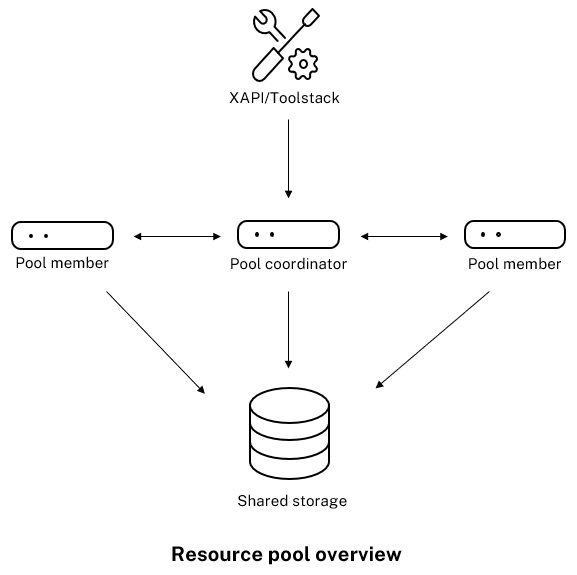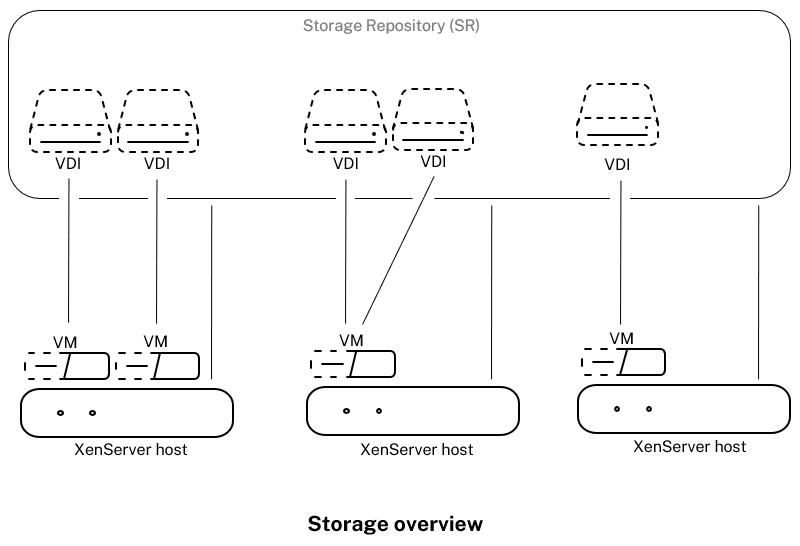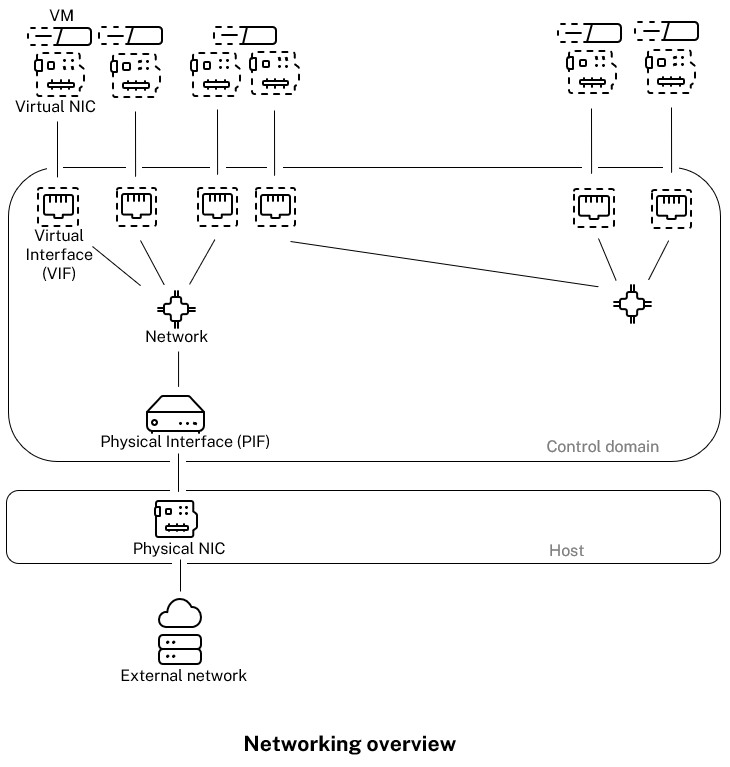Technical overview
XenServer (formerly Citrix Hypervisor™) is an industry leading platform for cost-effective desktop, server, and cloud virtualization infrastructures. XenServer enables organizations of any size or type to consolidate and transform compute resources into virtual workloads for today’s data center requirements. Meanwhile, it ensures a seamless pathway for moving workloads to the cloud.
The key features of XenServer® are:
- Consolidating multiple virtual machines (VMs) onto a physical server
- Reducing the number of separate disk images to be managed
- Allowing for easy integration with existing networking and storage infrastructures
- Enabling you to schedule zero downtime maintenance by live migrating VMs between XenServer hosts
- Assuring availability of VMs by using high availability to configure policies that restart VMs on another host in case one fails
- Increasing portability of VM images, as one VM image works on a range of deployment infrastructures
Virtualization and hypervisor
Virtualization, or to be more specific, hardware virtualization, is a method of running multiple independent VMs on a single physical computer. Software run on these virtual machines is separated from the underlying hardware resources. It’s a way of fully utilizing the physical resources available in modern powerful servers, which reduces the total cost of ownership (TCO) for server deployments.
A hypervisor is the basic abstraction layer of software. The hypervisor performs low-level tasks such as CPU scheduling and is responsible for memory isolation for resident VMs. The hypervisor abstracts the hardware for the VMs. The hypervisor has no knowledge of networking, external storage devices, video, and so on.
Key components
This section gives you a high-level understanding of how XenServer works. See the following illustration for the key components of XenServer:

Hardware
The hardware layer contains the physical server components, such as CPU, memory, network, and disk drives.
You need an Intel VT or AMD-V 64-bit x86-based system with one or more CPUs to run all supported guest operating systems. For more information about XenServer host system requirements, see System requirements. For a complete list of XenServer certified hardware and systems, see the Hardware Compatibility List (HCL).
Xen® Hypervisor
The Xen Project hypervisor is an open-source type-1 or bare-metal hypervisor. It allows many instances of an operating system or different operating systems to run in parallel on a single machine (or host). Xen hypervisor is used as the basis for many different commercial and open-source applications, such as: server virtualization, Infrastructure as a Service (IaaS), desktop virtualization, security applications, embedded, and hardware appliances.
XenServer is based on the Xen Project hypervisor and on top of that we provide extra features and support. XenServer uses version 4.13.4 of the Xen hypervisor.
Control domain
The Control Domain, also called Domain 0, or dom0, is a secure, privileged Linux VM that runs the XenServer management toolstack known as XAPI. This Linux VM is based on a CentOS 7.5 distribution. Besides providing XenServer management functions, dom0 also runs the physical device drivers for networking, storage, and so on. The control domain can talk to the hypervisor to instruct it to start or stop guest VMs.
Toolstack
The Toolstack, or XAPI is the software stack that controls VM lifecycle operations, host and VM networking, VM storage, and user authentication. It also allows the management of XenServer resource pools. XAPI provides the publicly documented management API, which is used by all tools that manage VMs, and resource pools. For more information, see the XenServer Management API.
Guest domain (VMs)
Guest domains are user-created virtual machines that request resources from dom0. For a detailed list of the supported distributions, see Supported Guests, Virtual Memory, and Disk Size Limits.
Full virtualization
Full virtualization, or hardware-assisted virtualization uses virtualization extensions from the host CPU to virtualize guests. Fully virtualized guests do not require any kernel support. The guest is called a hardware virtual machine (HVM). HVM requires Intel VT or AMD-V hardware extensions for memory and privileged operations. XenServer uses Quick Emulator (QEMU) to emulate PC hardware, including BIOS, IDE disk controller, VGA graphic adaptor, USB controller, network adapter, and so on. To improve the performance of hardware-sensitive operations like disk or network access, HVM guests are installed with the XenServer tools. For more information, see PV on HVM.
HVM is commonly used when virtualizing an operating system such as Microsoft Windows where it is impossible to modify the kernel to make it virtualization aware.
PV on HVM
PV on HVM is a mixture of paravirtualization and full hardware virtualization. The primary goal is to boost performance of HVM guests by using specially optimized paravirtualized drivers. This mode allows you to take advantage of the x86 virtual container technologies in newer processors for improved performance. Network and storage access from these guests still operate in PV mode, using drivers built in to the kernels.
Windows and Linux distributions are available in PV on HVM mode in XenServer. For a list of supported distributions using PV on HVM, see Guest Operating System Support.
XenServer VM Tools
XenServer VM Tools (formerly Citrix VM Tools or XenServer PV Tools) provide high performance I/O services without the overhead of traditional device emulation.
-
XenServer VM Tools for Windows consist of I/O drivers (also known as paravirtualized drivers or PV drivers) and the Management Agent.
The I/O drivers contain front-end storage and network drivers, and low-level management interfaces. These drivers replace the emulated devices and provide high-speed transport between VMs and XenServer product family software.
The Management Agent, also known as the guest agent, is responsible for high-level virtual machine management features. It provides full functionality to XenCenter® (for Windows VMs).
XenServer VM Tools for Windows must be installed on each Windows VM for the VM to have a fully supported configuration. A VM functions without the XenServer VM Tools for Windows, but performance will be significantly hampered when the I/O drivers (PV drivers) are not installed.
-
XenServer VM Tools for Linux contain a guest agent that provides extra information about the VM to the host. Install the guest agent on each Linux VM to enable Dynamic Memory Control (DMC).
Note:
You cannot use the Dynamic Memory Control (DMC) feature on Red Hat Enterprise Linux 8, Red Hat Enterprise Linux 9, Rocky Linux 8, Rocky Linux 9, CentOS Stream 9, or CentOS Stream 10 VMs as these operating systems do not support memory ballooning with the Xen hypervisor.
For more information, see XenServer VM Tools.
Key concepts
Resource pool
XenServer allows you to manage multiple hosts and their connected shared storage as a single entity by using resource pools. Resource pools enable you to move and run virtual machines on different XenServer hosts. They also allow all hosts to share a common framework for network and storage. A pool can contain up to 64 hosts running the same version of XenServer software, at the same patch level, and with broadly compatible hardware. For more information, see Hosts and resource pools.

XenServer resource pool adopts a primary/secondaries architecture, implemented by XAPI. XAPI calls are forwarded from the pool coordinator (the primary) to pool members (the secondaries). Pool members make DB RPCs against the pool coordinator. The pool coordinator is responsible for coordination and locking resources within the pool, and processes all control operations. Pool members talk to the pool coordinator through HTTP and XMLRPC, but they can talk to each other (over the same channel) through mirror disks (storage migration)
Storage repository
XenServer storage targets are called storage repositories (SRs). A storage repository stores Virtual Disk Images (VDIs), which contains the contents of a virtual disk. SRs are flexible, with built-in support for SATA, SCSI, NVMe, and SAS drives that are locally connected, and iSCSI, NFS, SAS, SMB, and Fibre Channel remotely connected. The SR and VDI abstractions allow advanced storage features such as thin provisioning, VDI snapshots, and fast cloning to be exposed on storage targets that support them.

Each XenServer host can use multiple SRs and different SR types simultaneously. These SRs can be shared between hosts or dedicated to particular hosts. Shared storage is pooled between multiple hosts within a defined resource pool. A shared SR must be network-accessible to each host in the pool. All hosts in a single resource pool must have at least one shared SR. Shared storage cannot be shared between multiple pools.
For more information about how to operate with SRs, see Configure storage.
Networking
On an architecture level, there are three types of server-side software objects to represent networking entities. These objects are:
- A PIF, which is a software object used within dom0 and represents a physical NIC on a server. PIF objects have a name and description, a UUID, the parameters of the NIC that they represent, and the network and host they are connected to.
- A VIF, which is a software object used within dom0 and represents a virtual NIC on a virtual machine. VIF objects have a name and description, a UUID, and the network and VM they are connected to.
- A network, which is a virtual Ethernet switch on a host used to route network traffic on a network host. Network objects have a name and description, a UUID, and the collection of VIFs and PIFs connected to them.

XenServer management APIs allow following operations:
- Configuration of networking options
- Control over the NIC to be used for management operations
- Creation of advanced networking features such as VLANs and NIC bonds
For more information about how to manage networks on XenServer, see Networking.
Related add-ons and applications
XenServer provides the core hypervisor features. To make your virtualization experience complete, you can add these related applications and services.
XenServer-specific add-ons:
-
XenCenter
A Windows GUI client for VM management, implemented based on the management API. XenCenter provides a rich user experience to manage multiple XenServer hosts, resource pools, and the entire virtual infrastructure associated with them.
-
Workload Balancing (WLB)
An appliance that balances your pool by relocating virtual machines onto the best possible hosts for their workload in a resource pool. For more information, see Workload balancing (/en-us/xenserver/8/wlb.html).
-
Conversion Manager
A virtual appliance that enables users to convert existing VMware virtual machines into XenServer virtual machines, with comparable networking and storage connectivity. For more information, see Conversion manager.
Related Citrix® products:
-
Citrix Licensing Server
A Windows application that XenCenter contacts to request a license for the specified server and that collects telemetry about your XenServer environment.
-
License Activation Service
The Citrix License Server reaches out to this service to verify what XenServer licenses your organization holds.
-
Citrix Provisioning™
Provisioning Services that support PXE boot from common images. Used widely with Citrix Virtual Desktops and Citrix Virtual Apps. For more information, see Provisioning.
-
Citrix Virtual Desktops™
A Virtual Desktop Infrastructure (VDI) product specialized to Windows desktops. Citrix Virtual Desktops uses XAPI to manage XenServer in a multi-host pool configuration. For more information, see Citrix Virtual Apps and Desktops.